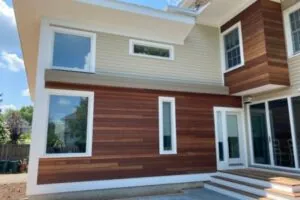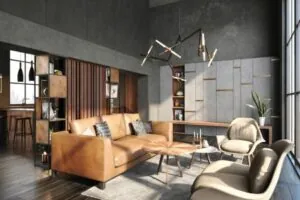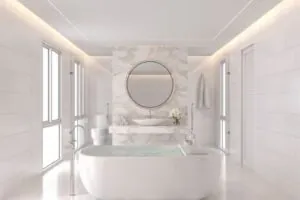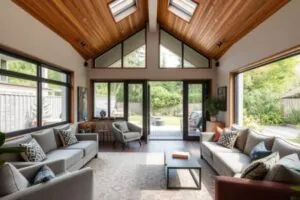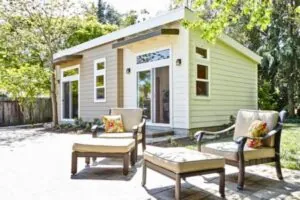Your home is more than just walls and furniture—it is a space that shapes how you feel, think, and live. Have you ever noticed how some rooms make you feel relaxed while others seem to drain your energy? That is not a coincidence. The psychology of home design reveals that everything from layout to color choice impacts emotions, productivity, and overall well-being. A cluttered, poorly lit space can create stress, while an open, well-organized room can foster calmness and connection.
Colors play a significant role, too. Soft blues and greens encourage relaxation, while bold reds and yellows energize a space. Even something as simple as how natural light flows through a room can affect your mood. Thoughtfully designing your home’s layout can create a home that supports your mental and emotional well-being.
This article explores how home layouts shape interactions, the psychological effects of colors, the impact of natural light, and why decluttering reduces stress. Whether you are planning a remodel or just making small changes, understanding these principles can help you create a harmonious, uplifting home that enhances daily life. Let’s dive into the psychology behind your space and how to make it work for you.
Why Your Home’s Design Affects Your Well-Being
Your home environment directly influences your mental and emotional health. Every element, from layout choices to clutter levels, plays a role in how you feel daily. A fcan enhance focus, relaxation, and social connection, while poor design can create stress and discomfort. Understanding these factors helps you make informed design choices.
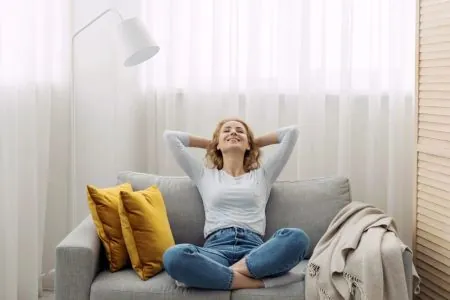
The Role of Open vs. Closed Layouts in Mental Clarity
In home remodeling, the layout plays a crucial role in shaping how you think, feel, and function. Open floor plans encourage social interaction and adaptability, making them ideal for fostering connection and multitasking. They enhance airflow and maximize natural light, which can boost focus and creativity. However, excessive openness may lead to sensory overload, making it difficult to concentrate and maintain a sense of privacy. Striking the right balance ensures a space that is both inviting and functional.
On the other hand, more restrained and closed-off layouts offer privacy and separation, reducing distractions and creating designated areas for relaxation or work. They help maintain boundaries between different activities, which can improve mental clarity and productivity. The best layout depends on your lifestyle—if you need structure, a closed layout may work better; if you thrive on openness, an open design might be ideal.
How Clutter Impacts Stress Levels
Clutter overwhelms the brain, making it difficult to focus and process information. Studies show that messy environments increase cortisol levels, the stress hormone, leading to anxiety and mental fatigue. When your home feels chaotic, it can trigger feelings of being out of control, affecting overall well-being.
A clutter-free space, however, promotes calmness and efficiency. Organizing your home reduces visual distractions, making relaxing and completing tasks easier. Simple changes—like decluttering countertops, organizing storage, keeping desk areas clean, and maintaining order—can significantly improve mood and mental clarity. A well-organized space fosters a sense of peace, making you feel more in control and productive in your daily life.
The Color Theory: What Each Shade Does to Your Brain
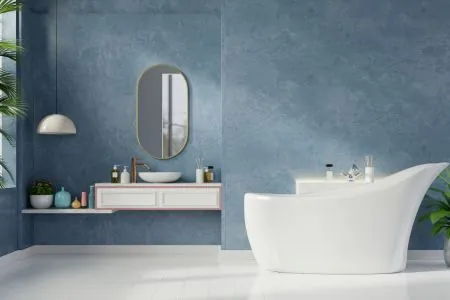
The psychology of home design impacts one’s mood and behavior greatly. Different shades trigger specific emotional responses, influencing relaxation, energy, and focus. Choosing the right colors for each room can create a more functional and harmonious home. Understanding color psychology helps homeowners make informed home layout and design choices that enhance well-being.
Best Colors for a Relaxing Bathroom
A bathroom should be a calming retreat, and color choice plays a major role in setting the right atmosphere. Soft blues and greens are ideal for relaxation, mimicking nature and promoting a spa-like feel. These colors lower stress levels and help create a space for unwinding after a long day of dealing with real life.
Neutral tones like beige, taupe, or light gray also contribute to a soothing environment. They provide a sense of cleanliness and simplicity without feeling overwhelming. Avoid overly bright or dark shades, which can feel jarring or heavy. A balance of cool, soft hues ensures a peaceful and restorative bathroom environment.
Energizing Colors for a Kitchen Remodel
The kitchen is the heart of the home, where energy and activity thrive. Bright, warm colors like yellow, red, and orange stimulate appetite and encourage social interaction. Yellow, in particular, boosts happiness and positivity, making a space feel more inviting. Kitchens are a place of energy and movement, so bolder colors help charge the area for all the fun activities.
For a modern, vibrant look, bold greens or deep blues can add character while maintaining energy. These shades create a lively atmosphere without feeling overwhelming. Avoid dull or overly dark colors, as they can make the kitchen feel closed off. A well-balanced palette keeps the space engaging, fresh, and functional.
Natural Light & Space: The Secret to a Happy Home
Natural light enhances mood, productivity, and overall well-being. Homes with ample sunlight feel more open, warm, and inviting, reducing stress and boosting energy. Proper lighting design can transform a space, making it feel more extensive and more comfortable. Maximizing natural light helps create a balanced and uplifting living environment.
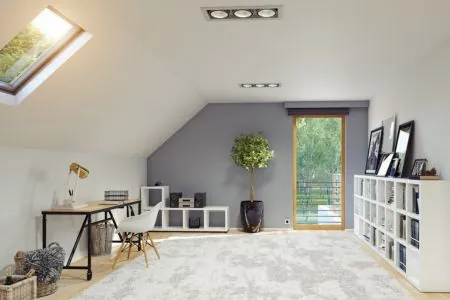
How Windows and Lighting Create Warmth and Positivity
Windows are the primary natural light source, influencing how a space feels throughout the day. Sunlight triggers the release of serotonin, improving mood and promoting relaxation. Large windows or strategically placed skylights allow more daylight to flow in, reducing reliance on artificial lighting and creating a more harmonious atmosphere.
Complementing natural light with well-placed artificial lighting enhances warmth, especially in dimly lit areas. Soft white or warm yellow bulbs create a cozy, welcoming feel, while layered lighting—such as task, accent, and ambient lights—ensures functionality and balance. Rooms with limited windows can benefit from mirrors and reflective surfaces, which bounce light and make spaces feel brighter. Proper lighting fosters positivity, comfort, and a visually appealing home.
How to Incorporate Psychology into Your Next Remodel
Applying the psychology of the home design concept ensures a space that supports well-being, comfort, and functionality. Thoughtful choices in home design layout ideas, color, and lighting can shape emotions, improve productivity, and enhance relaxation. Whether you’re renovating a single room or your entire home, understanding design psychology helps create a space that truly works for you.
Practical Tips for Selecting Colors and Layouts That Fit Your Needs
Choosing the right colors and layouts depends on how you use the space. Opt for cool tones like blue or green in bedrooms and bathrooms for relaxation. If you want energy and warmth, reds, yellows, and oranges work well in social areas like kitchens and dining rooms.
When planning your layout, consider how you move through the space. Open layouts encourage interaction, making them ideal for family areas, while closed layouts create privacy for offices and bedrooms. Maximize natural light by positioning windows strategically and using mirrors to reflect brightness. A well-planned remodel combines functionality and psychology, ensuring your home enhances both mood and lifestyle.
Final Thoughts: Small Changes, Big Impact on Your Home’s Atmosphere
Your home is more than just a place to live—it is a space that shapes your emotions, productivity, and overall well-being. By understanding the psychology of personal home design, you can create an environment that enhances relaxation, energy, and connection. Thoughtful choices in layout, color, lighting, and organization can significantly impact how you feel every day. Whether planning a simple refresh or a complete remodel, prioritizing design psychology ensures a home that truly supports your lifestyle.
Ready to transform your space? CCH Design specializes in home renovations in Meridian, ID, helping homeowners design functional and beautiful spaces. Contact us today to bring your vision to life!
FAQs on the Psychology of Home Design
1. How does home design impact mental and emotional well-being?
Home design influences mood, productivity, and overall well-being. Elements like layout, color, lighting, and clutter affect stress levels, relaxation, and focus. A well-designed space can promote calmness and connection, while a poorly planned one can cause stress and discomfort.
2. What are the best colors to use for different rooms based on psychology?
Colors have a significant psychological impact. Soft blues and greens are ideal for relaxation in bedrooms and bathrooms, while warm tones like reds and yellows energize kitchens and dining spaces. Neutral shades help create balance and sophistication in living areas.
3. Why is natural light important in home design?
Natural light boosts serotonin levels, improving mood, focus, and energy. Homes with ample sunlight feel more open and welcoming. Proper lighting, including large windows and reflective surfaces, enhances both comfort and aesthetics.
4. How can clutter affect stress levels in a home?
Clutter creates mental overwhelm by increasing cortisol levels, leading to stress and reduced productivity. Organizing your space and maintaining a clean environment can improve mental clarity, making your home feel more peaceful and functional.
5. How can I use psychology to make my home more comfortable and inviting?
Incorporate open or closed layouts based on your lifestyle, choose colors that support desired moods, maximize natural light, and declutter spaces. Thoughtful design choices create an environment that enhances emotional well-being and daily life.


